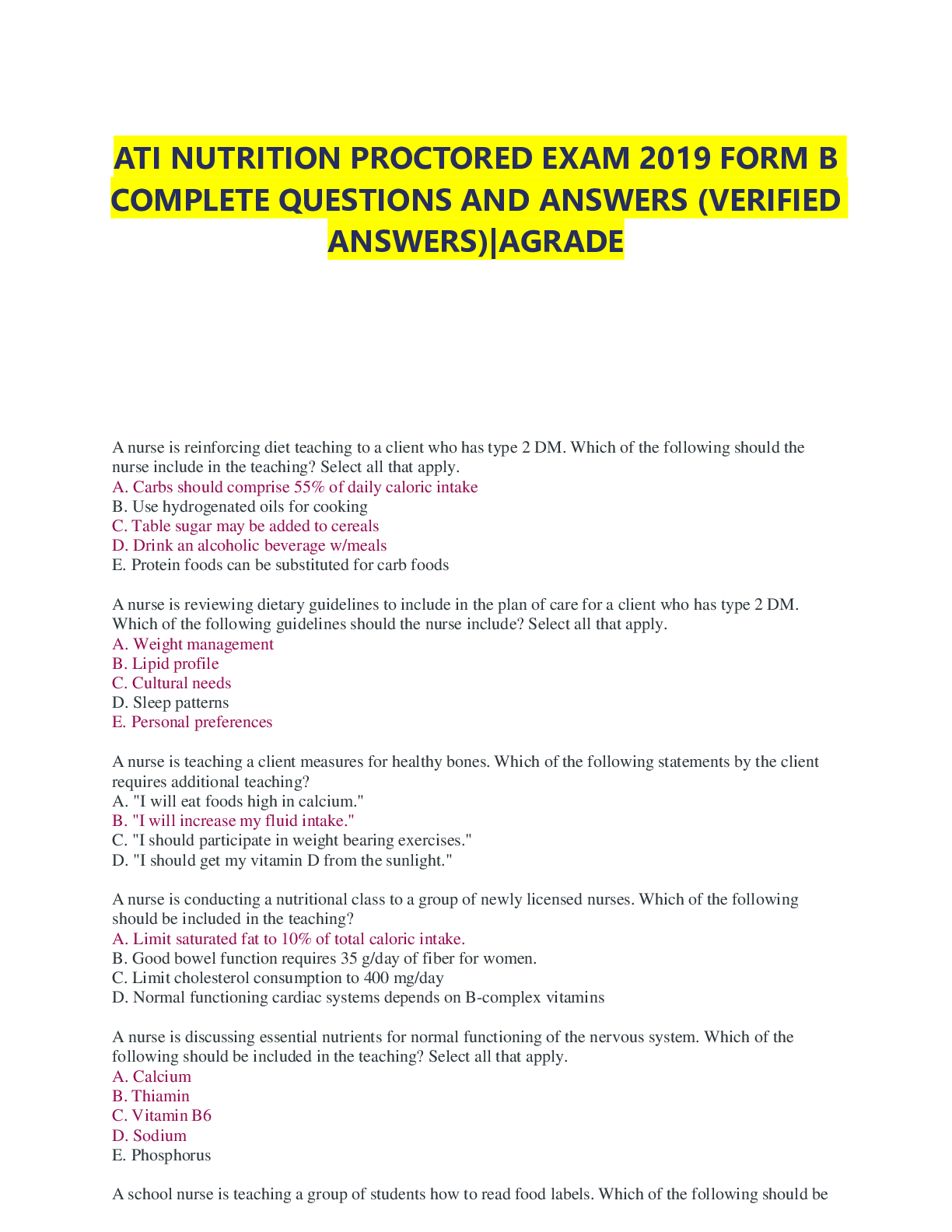*NURSING > EXAM > CNRN Week 1 Neurological Anatomy, Physiology, & Assessment Review Questions with Answers,100% CORREC (All)
CNRN Week 1 Neurological Anatomy, Physiology, & Assessment Review Questions with Answers,100% CORRECT
Document Content and Description Below
CNRN Week 1 Neurological Anatomy, Physiology, & Assessment Review Questions with Answers How many cranial bones are there? Name them - CORRECT ANSWER 8 Cranial Bones Frontal, Parietal x2, Tempor... al x2, Occipital, Sphenoid, Ethmoid What are the thickest cranial bones? - CORRECT ANSWER Frontal and Occipital What is the Monroe-Kellie Hypothesis? - CORRECT ANSWER - The skull is a fixed box - Made of 3 components - Brain (80%) - CSF (10%) - Blood (10%) - It maintained homeostasis - Meaning that an increase in one needs to decrease one or two of the other. What are the 3 components of the meninges? - CORRECT ANSWER Dura mater Arachnoid mater Pia mater Dura Mater - CORRECT ANSWER - Thickest - Outer layer lining skull - Non elastic - Under the bone - Vascular Arachnoid Mater - CORRECT ANSWER - Middle layer - Subarachnoid space - Consist of blood vessels and CSF - Arachnoid villi - reabsorb CSF - None vascular Pia Mater - CORRECT ANSWER - Innermost layer - Adheres to the brain - Choroid plexus - produces CSF - Vascular - Thicker in spine Cerebral Spinal Fluid (CSF) - CORRECT ANSWER - Functions as a cushion - Produced by choroid plexus - Absorbed by arachnoid villi and dumped back into circulation via venous sinuses How much CSF is produced daily? And where is it produced? - CORRECT ANSWER 500 mL produced Produced by the choroid plexus What is the CSF flow pathway? - CORRECT ANSWER - Foramen of monro - 3rd ventricle - Cerebral Aqueduct - 4th ventricle - Out through subarachnoid space - Down into spinal arachnoid space Gray Matter - CORRECT ANSWER Cell bodies Unmyelinated Where synapsis occur Thinking area of the brain - Cognition, memory, through and personality 95% of oxygen in the brain goes through here Alcoholics and smokers have decrease in this type of matter due to atrophy White Matter - CORRECT ANSWER Neurons Myelinated Network of fibers that enable the gray matter of the brain to communicate with each other Corpus Collosum - CORRECT ANSWER Relays information between the right and left hemispheres Only connection point Thick band of nerve fibers Primary function is to integrate motor, sensory, and cognition from on side to the other. Allows for seizures to travel from one side of the brain to the other Frontal Lobe - CORRECT ANSWER - Characteristics: - Personality - Judgement - Inhibition - Short-term memory - Allows us to have socially acceptable behavior (when injured, people stop having filters) - Broca's area of speech - Dominant side - Expressive aphasia - Motor aspect of speech - End with motor strip - Cerebral perfusion - MCA (middle cerebral arteries) & ACA (Anterior cerebral arteries) - Boss of the brain Where does motor homunculus come from? - CORRECT ANSWER Frontal Lobe Where does sensory homunculus come from? - CORRECT ANSWER Thalamus Parietal Lobe - CORRECT ANSWER - Characteristics: - Proprioception (sensing body's position) - Spatial perception - Sensory interpretation - Begins with sensory strip - Cerebral perfusion - MCA: medial and lateral portions - ACA: superior portions Temporal Lobe - CORRECT ANSWER - Characteristics: - Long-term memory - Hearing, interprets sound (L side is dominant for most people) - Wenicke's area (Receptive aphasia and speech comprehension) - Cerebral perfusion - MCA: Superior to medial portion - PCA: Inferior and posterior portion - People with insult in this are should be on anti epileptic and slowly wean off. Which lobe deals with short term memory and which one deals with long term memory? - CORRECT ANSWER - Frontal Lobe - Short term - Temporal Lobe - Long term Name which arteries provide perfusions for each lobe - CORRECT ANSWER - Frontal Lobe - MCA (middle cerebral arteries) & ACA (Anterior cerebral arteries) - Parietal Lobe - MCA (medial and lateral portions) & ACA (superior portions) - Temporal Lobe - MCA (superior to medial portion) & PCA (posterior cerebral artery)(Inferior and posterior portion) - Occipital Lobe - PCA - Cerebellum - PICA (posterior inferior cerebellar artery), AICA (anterior inferior cerebellar artery), SCA (superior cerebellar artery) Occipital Lobe - CORRECT ANSWER - Characteristics: - Visual processing - Convergent end points of optic tracts - Homonymous Hemianopia - Happens when occipital lobe damage from tumor or stroke - Cerebral perfusion - PCA Cerebellum - CORRECT ANSWER - Characteristics: - Motor coordination, ataxia - Balance - Lies in posterior fossa - 10% of brain mass - Contains 50% of neurons - Cerebral perfusion - PICA (posterior inferior cerebellar artery), AICA (anterior inferior cerebellar artery), SCA (superior cerebellar artery) - Receives information from sensory and motor cortex - Injury needs to be monitor for 72-96 hours Which lobe of the brain is Wernicke's area located? a) Frontal b) Parietal c) Temporal d) Occipital - CORRECT ANSWER c) Temporal lobe What is the basal ganglia? - CORRECT ANSWER - Deep, subcortical tissue - Coordinates detailed movements - Suppression of unwanted movements - i.e. tremor, Parkinson's - Has both input and output nerves - Neuro transmitters present - Substantia nigra (dopamine site) - Perfused by the lenticulostriate arteries off the MCA - Collection of subcortical nuclei, cluster of nerve cells the contain gray and white matter - Found on both side of the thalamus, deep within the brain tissue. Thalamus - CORRECT ANSWER - Relays sensation, spatial sense (including pain), and motor signals - Regulates consciousness, sleep, and alertness - Surrounds third ventricle - PCA stroke which perfuses the thalamus the pt might be very sleepy, especially if bilateral Hypothalamus - CORRECT ANSWER Controls: - Body temperature - Hunger - Thirst - Fatigue - Sleep - Circadian cycles - Autonomic nervous system Pituitary Gland - CORRECT ANSWER - "Master Gland" - Houses and secretes hormones - Regulates growth and metabolism - Abnormalities come from noncancerous tumor which causes to overproduce or underproduces What of the 3 components of the Diencephalon? - CORRECT ANSWER 1) Thalamus 2) Hypothalamus 3) Pituitary Gland Name the Pituitary Hormones and where they are produced - CORRECT ANSWER Includes: - Thyroid Stimulating Hormone (TSH) - Thyroid gland - Luteinizing hormone/Follicle stimulating hormone (LH/FSH) - Testis & Ovary - Antidiuretic hormone (ADH) - Kidney tubules - ACTH (Adrenocorticotropic hormone) - Adrenal cortex - GH (Growth Hormone) - Bone - PRL (Prolactin) - Mammary Glands - Oxytocin - Muscles of uterus Internal capsule - CORRECT ANSWER - It provides rapid transmission of information - High concentration of sensory and motor fiber Limbic System - CORRECT ANSWER - Primitive behaviors - Filter for concentration - Amygdala and hippocampus What are the 3 components of the brainstem? - CORRECT ANSWER 1) Midbrain 2) Pons 3) Medulla What is the function of the brainstem? - CORRECT ANSWER - Regulates pulse, BP, breathing - Connects cerebrum with spinal cord - Cerebral perfusion - Vessels from the basilar artery - Routes motor and sensory input coordinating them to get send to the body Midbrain - CORRECT ANSWER Movements coordinated with visual input CN III and IV Pons - CORRECT ANSWER Arousal Respiratory centers CN V - VIII Medulla - CORRECT ANSWER Autonomic function, vasomotor Relay between brain and spinal cord CN IX - XII How is the brainstem used to determined brain death? - CORRECT ANSWER When a person loses function on these (midbrain, pons, or medulla) that person loses permanent ability for consciousness and capacity to breath Cerebral circulation - CORRECT ANSWER Brain uses 20% of the circulating volume Uses glucose and oxygen for metabolism but there's no reserves for either Cell death occurs within minutes when deprived of glucose and oxygen It has the highest demand of oxygen anywhere in the body How much of the circulating blood volume does the brain use at a time? - CORRECT ANSWER 20% Name the arteries that form the Circle of Willis and which supply the back of the brain and which supply the front of the brain? - CORRECT ANSWER Back of the brain: - Vertebral Artery (VA) - Basilary Artery (BA) Front of the brain: - Internal Carotid Arteries (ICA) - Anterior Cerebral Artery (ACA) - Anterior Communicating Artery (ACOM) - Middle Cerebral Artery (MCA) - Posterior Cerebral Artery (PCA) - Posterior Communicating Artery (PCOM) Circle of Willis - CORRECT ANSWER Collateral circulation Connection of blood vessels that helps preserve cerebral blood flow Anterior Cerebral Circulation - CORRECT ANSWER 80% of CBF (Cerebral blood flow) Internal Carotid Arteries (ICA) - CORRECT ANSWER Includes: - Middle cerebral artery (MCA) - Anterior cerebral artery (ACA) - Anterior communicating artery (ACOM) connects both hemispheres providing collateral blood flow Middle Cerebral Artery (MCA) - CORRECT ANSWER - Includes largest branch off of ICA - Areas supplied: - Majority of the frontal lobe - Anterior portion parietal lobe - Majority of temporal lobe - Lenticulostriate arteries - Perfuses the basal ganglia - Site for hypertensive hemorrhages Anterior Cerebral Artery (ACA) - CORRECT ANSWER - Areas supplied - Frontal lobe: superior aspect - Portion of motor strip that controls lower extremities Anterior Communicating Artery (ACOM) - CORRECT ANSWER Bilateral ACAs connected by ACOM Posterior Cerebral Circulation - CORRECT ANSWER 20% of cerebral blood flow Vertebrobasilar system - VAs pass through the base of the skull and converge to form the basilar at the level of the pons Basilar artery branches to form PCAs connecting ICA via the PCOM Basilar Artery - CORRECT ANSWER Essential to perfuse the posterior portion of the brain Areas supplied: - Portions of cerebellum AICA, SCA - Brainstem; pontine perforators Posterior Cerebral Artery - CORRECT ANSWER - Areas supplied: - Occipital lobes - Temporal lobes: inferior, lateral portions - Thalamus, midbrain, visual cortex - Posterior Communicating Artery - Connects posterior to anterior circulating via ICA While having her morning coffee, a 63-year-old female drops the cup from her right hand and has difficulty communicating with her husband. What cerebral blood vessel is most likely affected? a) Right ACA b) Left ACA c) Right MCA d) Left MCA - CORRECT ANSWER d) Left MCA Cerebral Venous Sinuses - CORRECT ANSWER Form the major venous drainage pathways for the brain - Lies within the dura; valveless Function - Receive blood from brain through cerebral veins and CSF from the SA space and empty into the jugular veins to reenter systemic circulation Olfactory nerve - CORRECT ANSWER CN I Sense of smell Optic nerve - CORRECT ANSWER CN II Sense of sight Central and peripheral vision Carries information from retina to the brain Oculomotor nerve - CORRECT ANSWER CN III Pupillary reaction (CN II, III) Trochlear (Superior Oblique) Nerve - CORRECT ANSWER CN IV Downward and outward (adduction) eye movement Eye movement toward nose SO4 Trigeminal nerve - CORRECT ANSWER CN V VI, V2, V3 Facial sensation Sensory and motor components Abducens (Lateral rectus) nerve - CORRECT ANSWER CN VI Abduction of the eye Eye movement towards ears LR6 Facial nerve - CORRECT ANSWER CN VII Facial movement Mouth, facial, forehead Fxn of salivary gland Vestibulocochlear nerve - CORRECT ANSWER CN VIII Sense of hearing and balance Glossopharyngeal - CORRECT ANSWER CN IX Controls uvula and pharynx Taste Vagus - CORRECT ANSWER CN X Cough, bear-down reflexes Spinal accessory nerve - CORRECT ANSWER CN XI Sternocleidomastoid muscle Neck, shoulder movement Hypoglossal nerve - CORRECT ANSWER CN XII Tongue Movement Which CN affect swallowing? - CORRECT ANSWER CN IX, X, and XII While performing a neurological assessment, the nurse notes the presence of homonymous hemianopia. What vessel perfuses the occipital lobe? 1) PCA 2) ACA 3) MCA 4) ICA - CORRECT ANSWER PCA How do you identify a pronator drift and what does a positive test mean? - CORRECT ANSWER - Arms out in front of body, palms up, and eyes closed - Drift present (+ test) - subtle sign of upper motor neuron weakness What are the 4 main dermatomes? - CORRECT ANSWER C2, C3 - Posterior head and neck T4 - Nipple T10 - Umbilicus What are the upper extremity dermatomes? - CORRECT ANSWER C6 - Thumb C7 - Middle finger C8 - Little finger T1 - Inner forearm T2 - Upper inner forearm What are the lower extremity dermatomes? - CORRECT ANSWER L3 - Knee L4 - Medial malleolus L5 - Dorsum of foot L5 - Toes 1-3 SI - Toes 4 and 5; lateral malleolus What is clonus? - CORRECT ANSWER Involuntary contractions and relaxations Associate with upper motor neuron lesions Decorticate posturing - CORRECT ANSWER Flexion Decerebrate posturing - CORRECT ANSWER Extension [Show More]
Last updated: 1 year ago
Preview 1 out of 16 pages
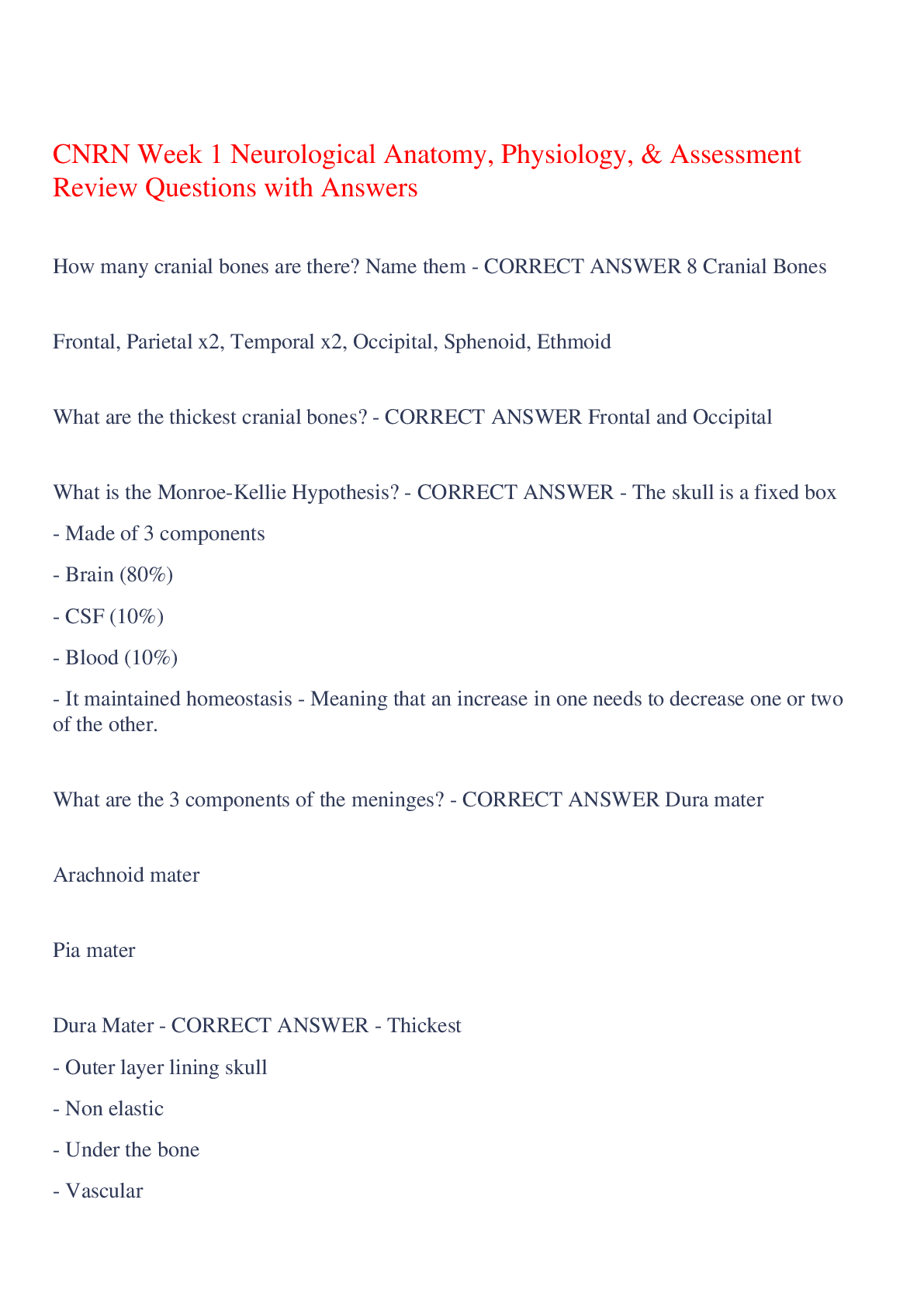
Buy this document to get the full access instantly
Instant Download Access after purchase
Buy NowInstant download
We Accept:

Reviews( 0 )
$10.00
Can't find what you want? Try our AI powered Search
Document information
Connected school, study & course
About the document
Uploaded On
Oct 24, 2023
Number of pages
16
Written in
Additional information
This document has been written for:
Uploaded
Oct 24, 2023
Downloads
0
Views
103



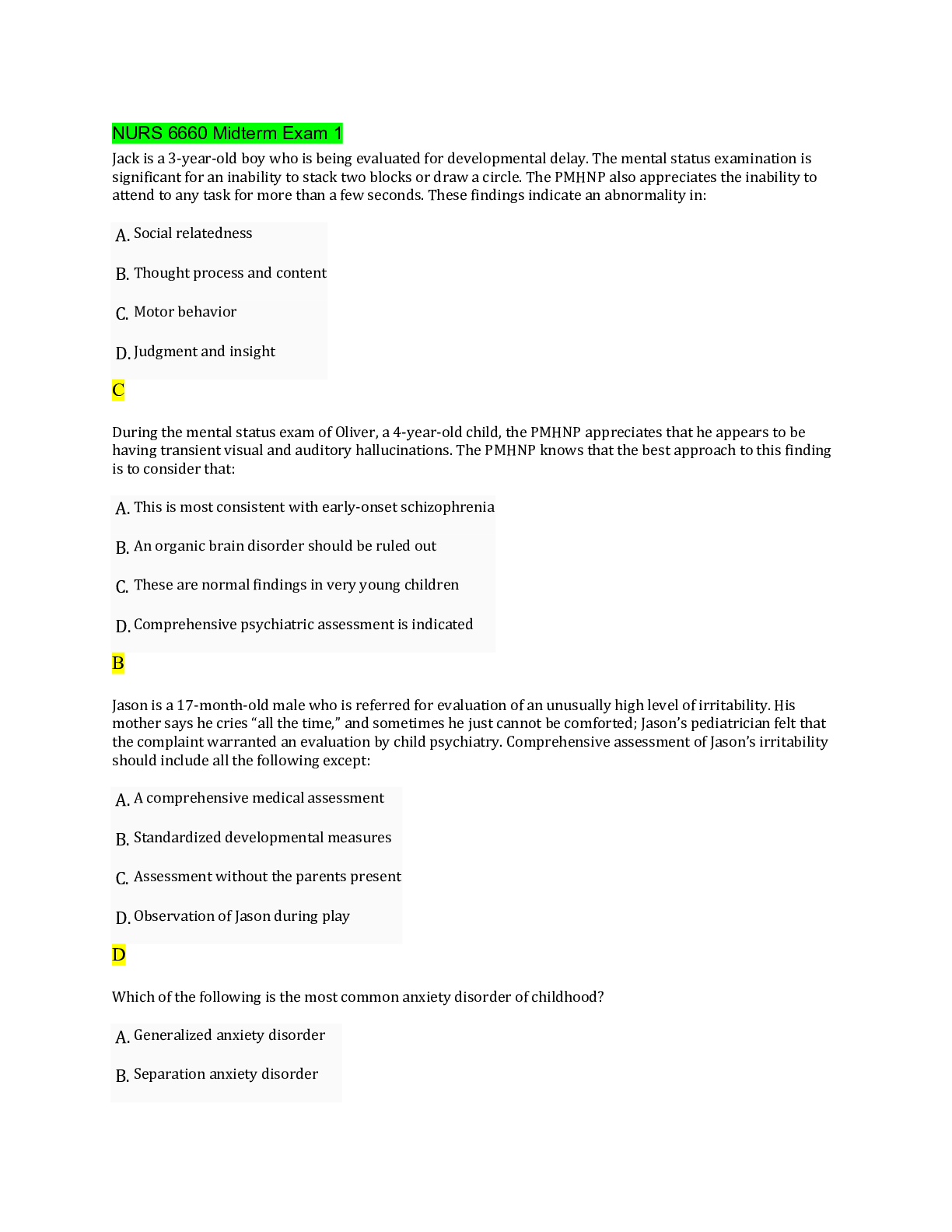
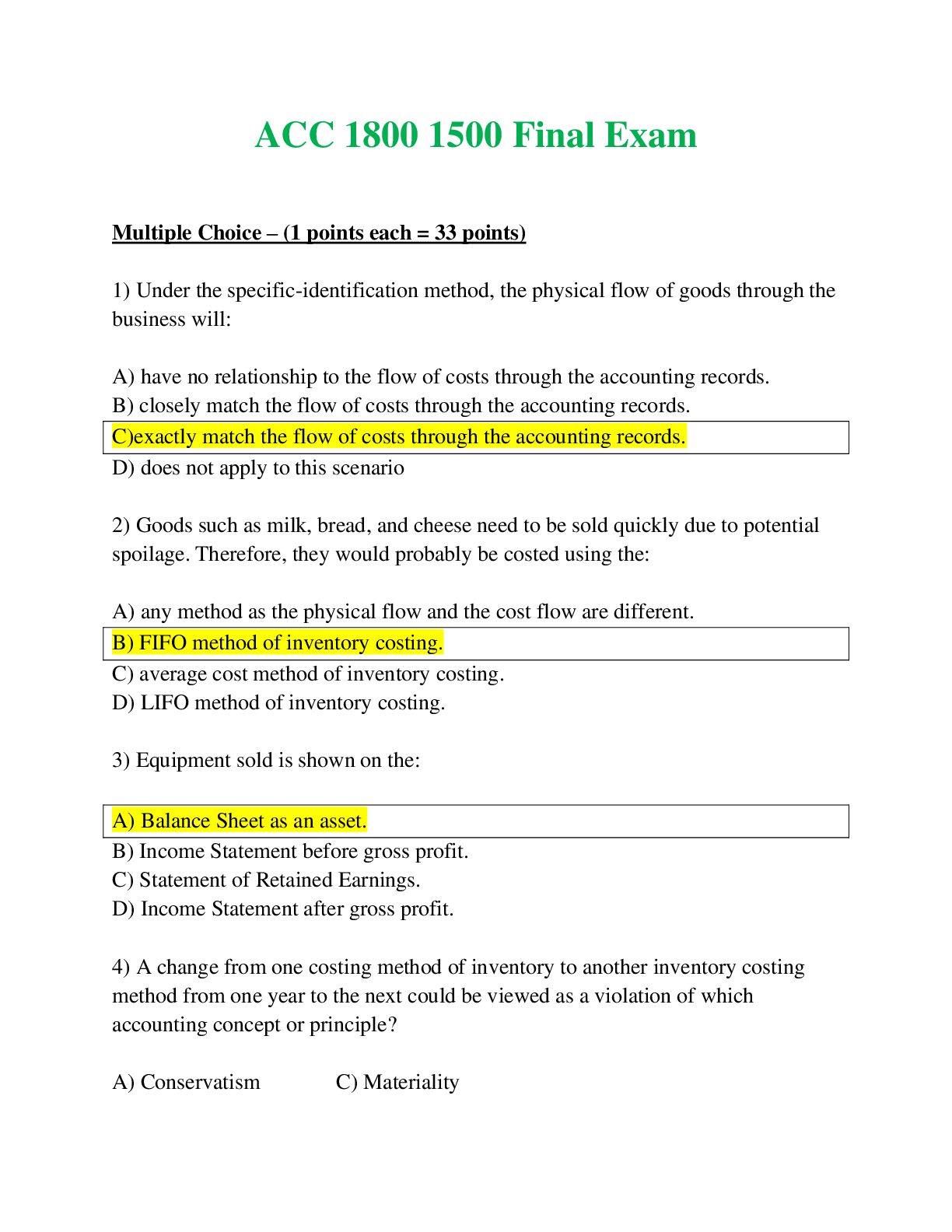

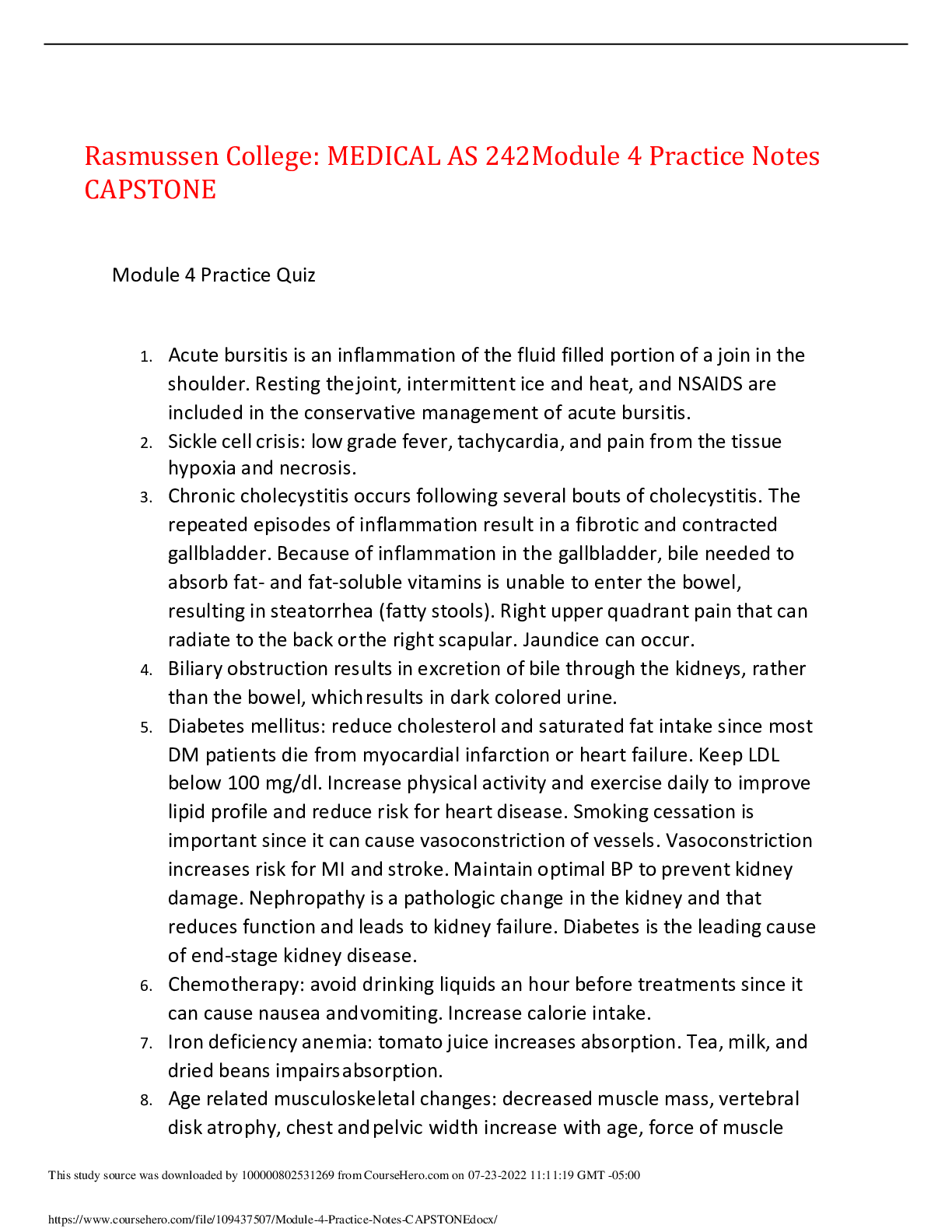
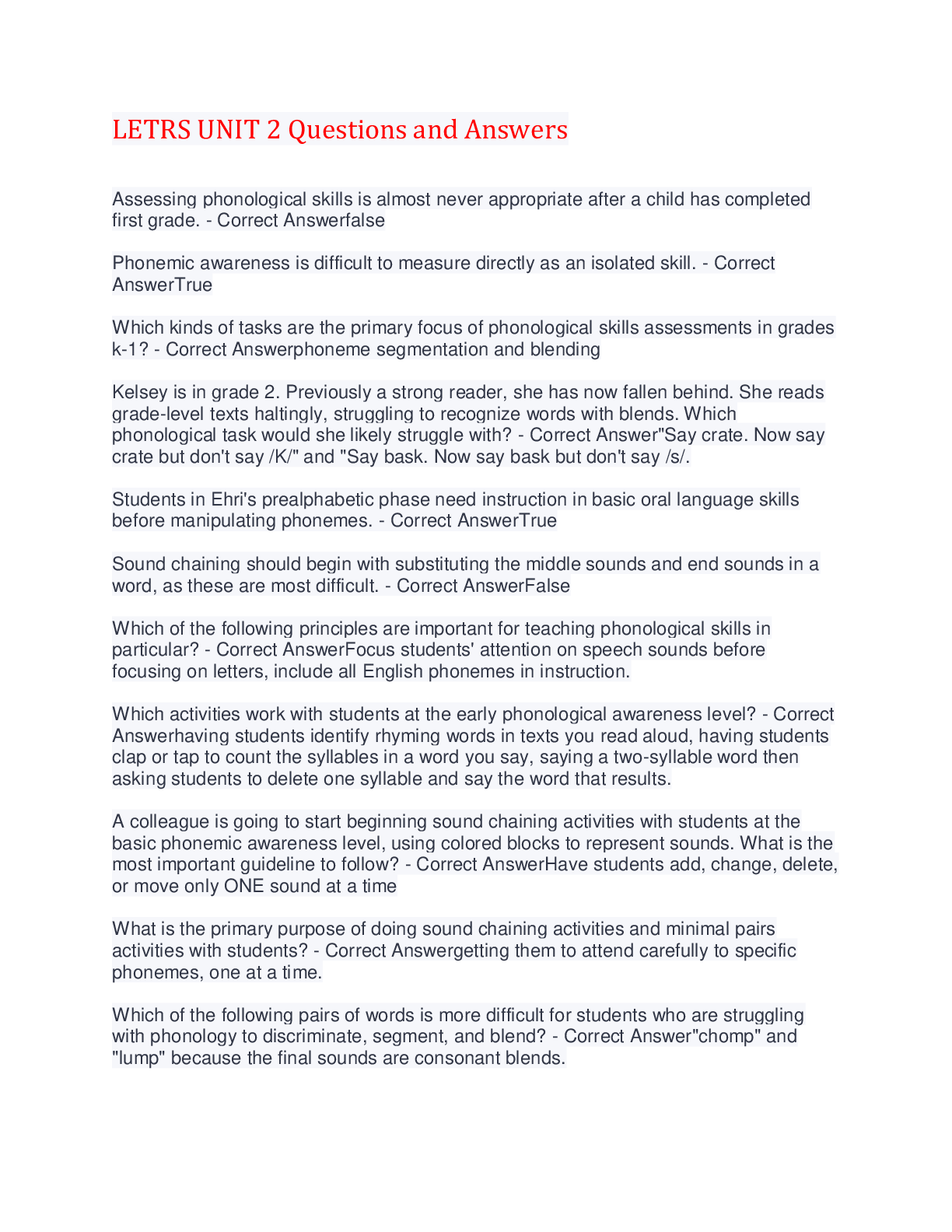
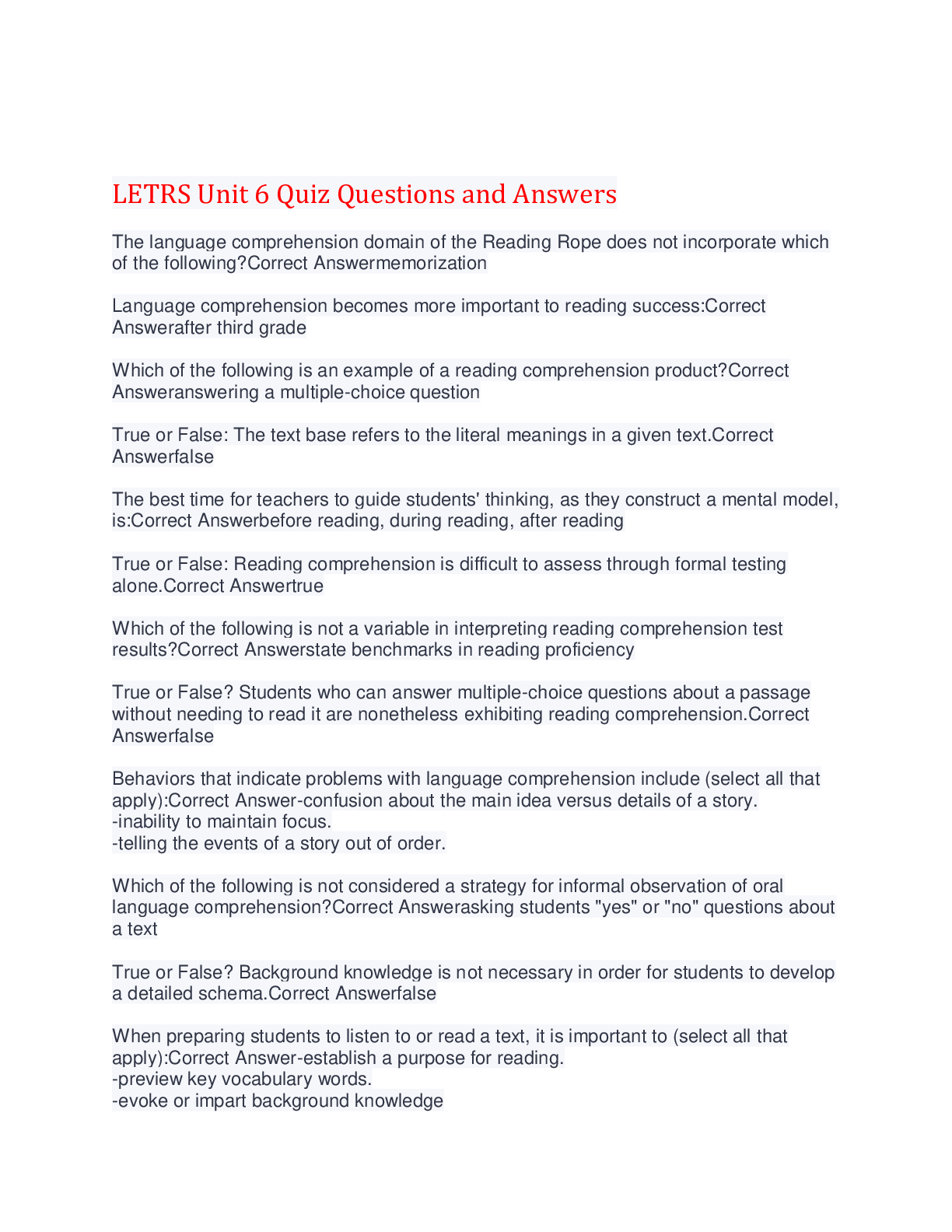
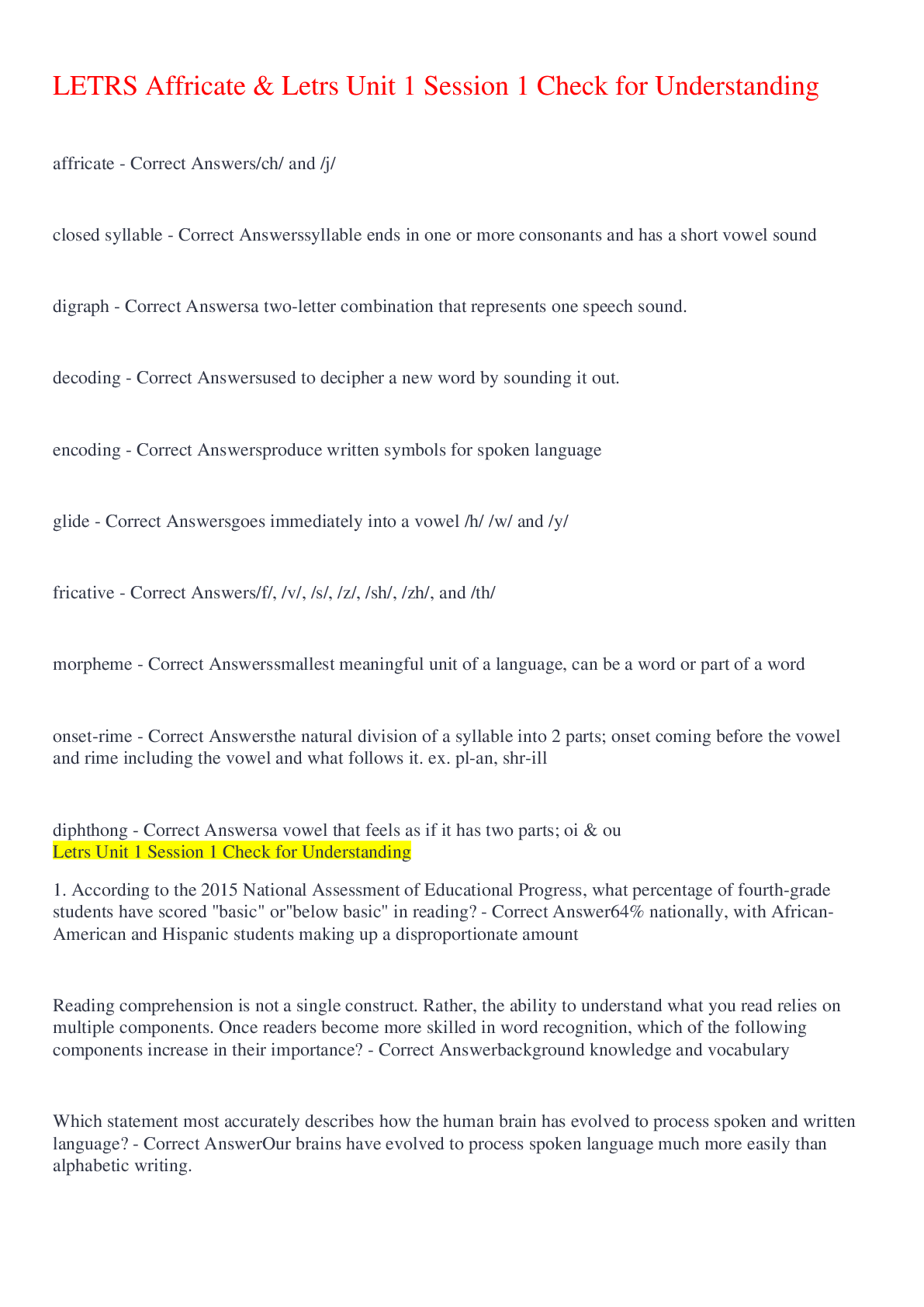

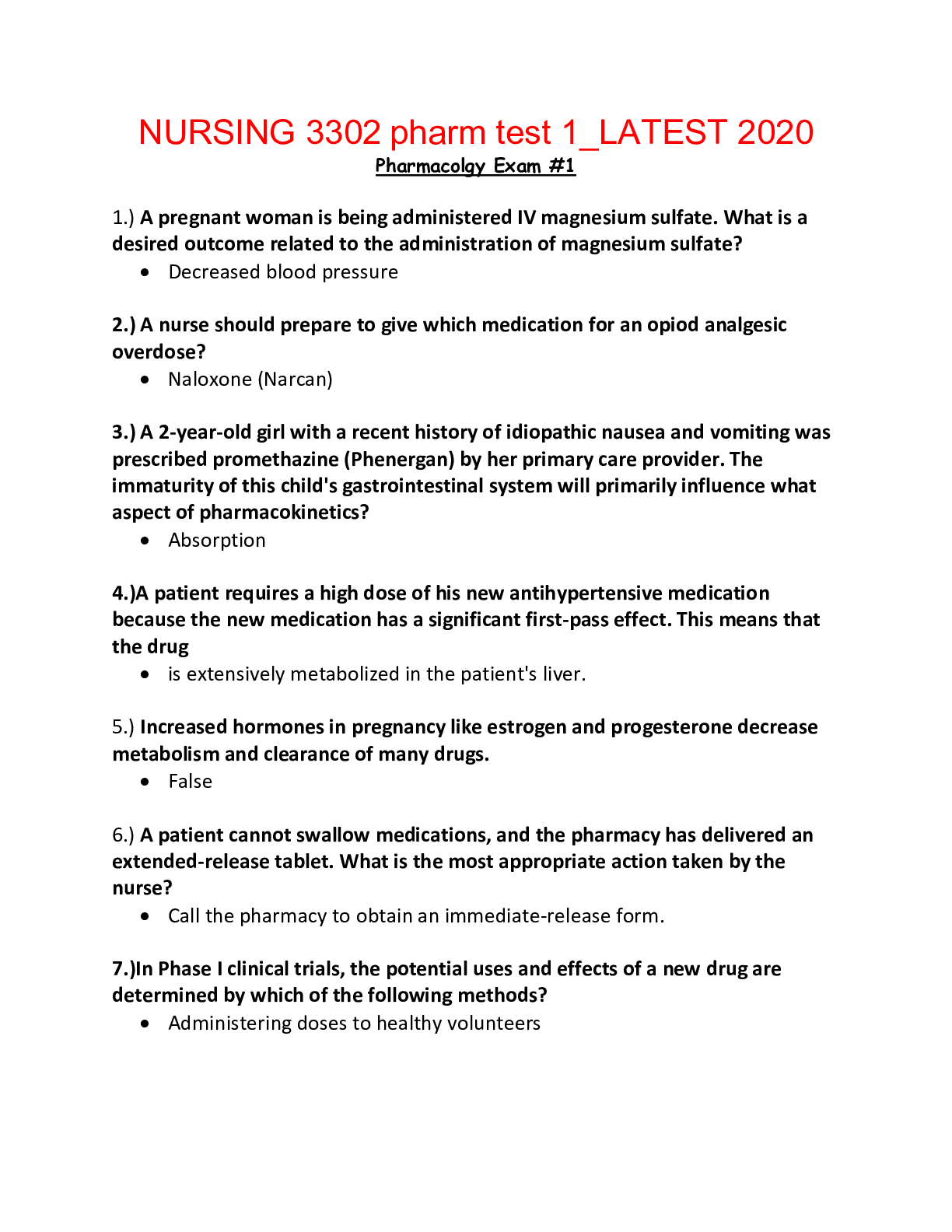
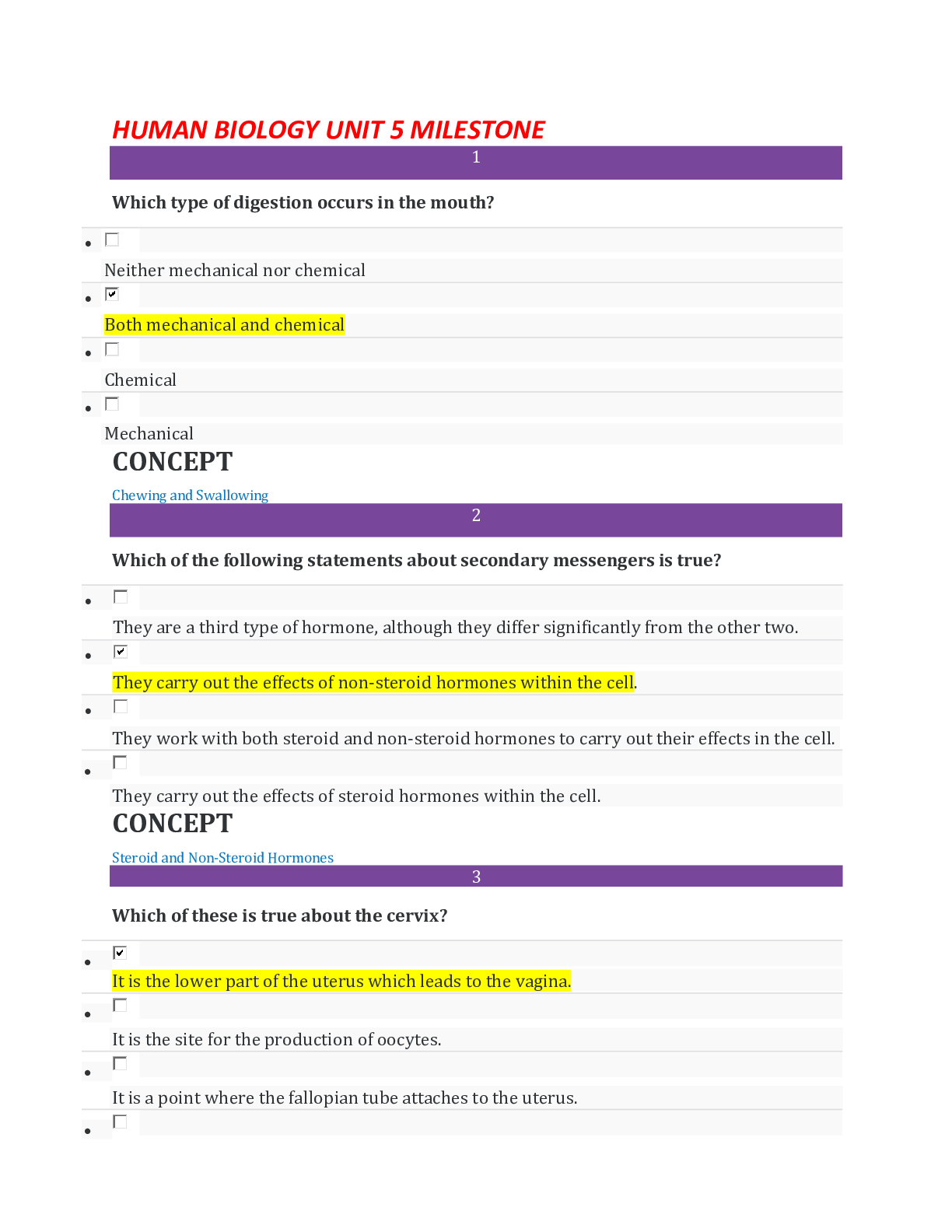
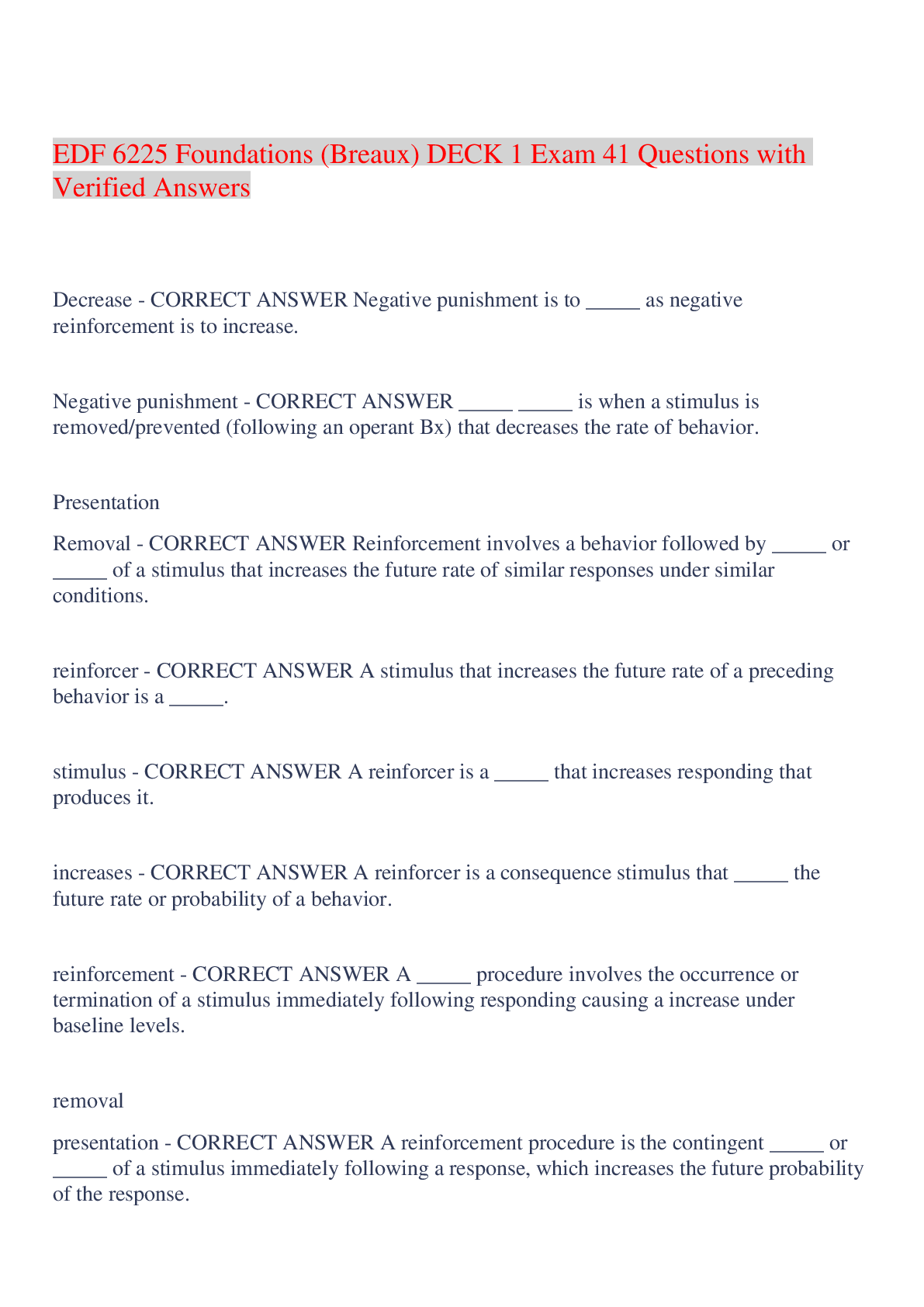
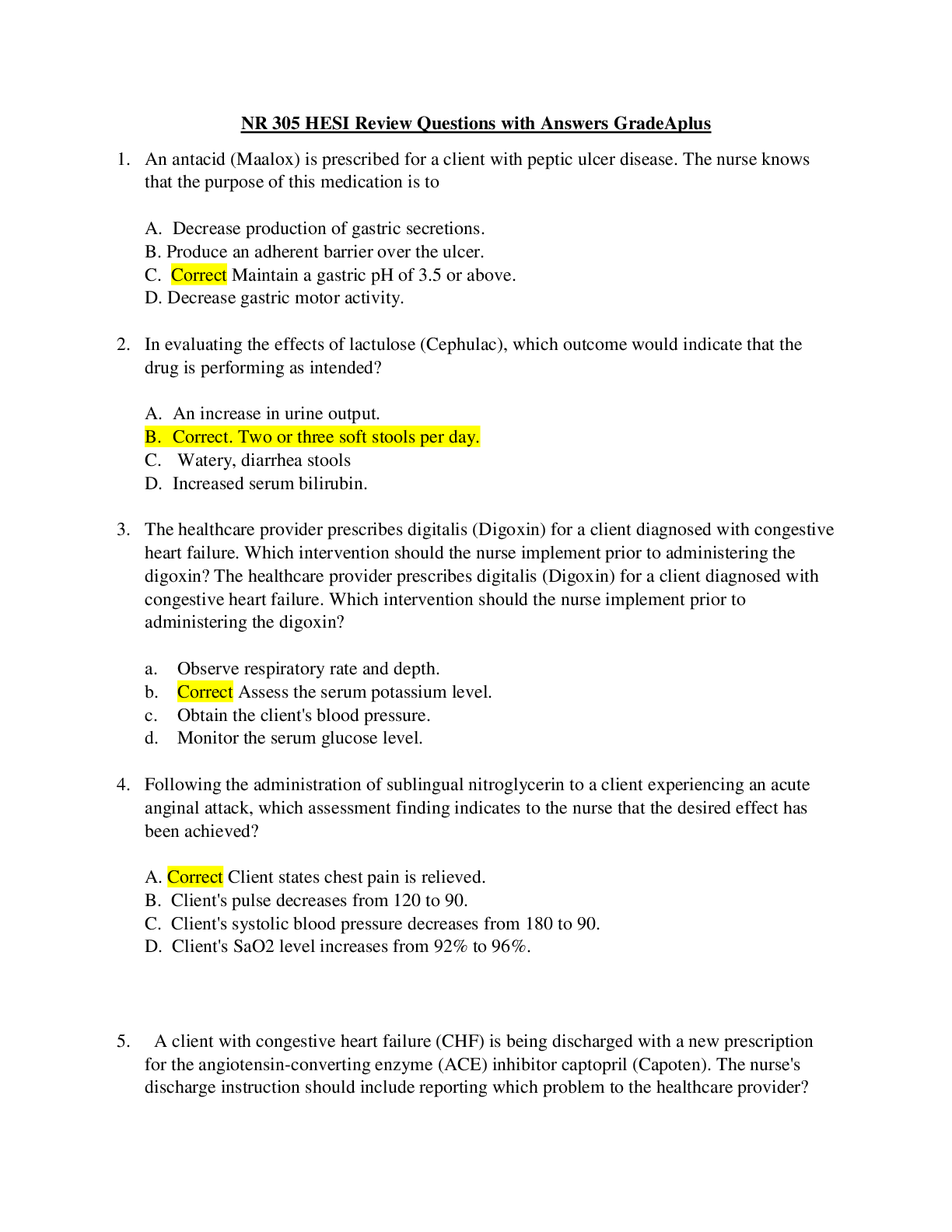

.png)








